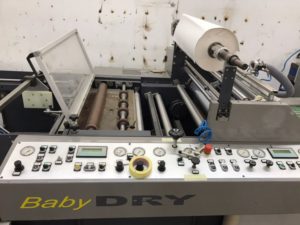 Industrial laminator – high-speed, automated devices for lamination, with a wide range of options.
Industrial laminator – high-speed, automated devices for lamination, with a wide range of options.
Despite the fact that the name “industrial” is not a strict term, there are some distinctive features that make it possible to classify a laminator as a class of industrial equipment.
Industrial Laminator
Industrial lamination implies the use of a high-performance modern industrial laminator. This method of lamination is probably the most in demand nowadays. As a rule, it is intended for laminating booklets, catalogs, magazines, laminating calendars, postcards or business cards.
On such a laminating machine, you can use a fairly thin film that makes the product elegant and presentable without adding excessive thickness and stiffness. The technology of hot pressing makes the products very durable and resistant.
Absolutely all industrial laminators:
- are equipped with rolls,
- have the possibility of lateral trimming,
- can work with materials of large thickness (up to several centimeters) and format (up to one and a half meters),
including reverse functions.
Industrial Laminators Model Line
Industrial laminators are equipped with automatic systems for adjusting the temperature of the shafts and the speed of drawing the laminated material. Modern features allow to automatically regulate the pressure during the laminating process.
There are 2 main models on industrial laminators for both one-sided and two-sided lamination. Optionally, the possibility of foil stamping may be present. The operations of heating the film and pressing it to the material of the document are carried out separately.
Heating and clamping (finishing) shafts, respectively. The clamping of the shafts can be carried out by both mechanical or hydraulic device.
Types of Lamination
What type of film to choose for industrial laminating, matte or glossy film? Most often, as a result of lamination, we expect to see the material in a shiny film. Glossy lamination is naturally the most popular type of lamination. It is suitable for laminating documents, calendars, posters, postcards, photos, restaurant menus, etc. Such lamination possesses the optical property of color enhancement, imparts saturation and brightness to colors.
Glossy lamination can literally save the impression of your product in case the result of printing is not the most successful one. But the appearance of excessive glare may not be desirable. Perhaps after you order the printing of leaflets, you will see they are not bright enough and you will want to use glossy lamination.
The matte film will remove unfortunate highlights, reduce unnecessary contrast, and the muffled color will create the impression of solidity and a high cost of production. Another feature of matte lamination is that its surface is suitable for writing on it with a pen or pencil.
Try to imagine your product catalog with a velvet cover, if you already like it, then matte lamination is your choice. But we must warn that such a product requires more careful handling, due to the fact that it can remain scratches and fingerprints.
Lamination as Protection
Often, to better save sheets of paper, we put them in a plastic file or folder. In fact, it was this goal that served as an active development of lamination technology. The film is able to protect the document from the influence of an aggressive environment: water, ultraviolet radiation, any chemical environment or the remains of greasy foods.
In addition, it is a good protection against crushing and other mechanical damage. For example, this is relevant for product catalogs or documents that are in constant use.
Possibilities of Lamination
Speaking about the possibilities of lamination, the product laminated with a vinyl film is so resistant to crushing that it can be bent and twisted into a tube. A special theme is laminating photos. Probably, many people carry photos of their beloved people, children, and we would like to see these photos safe for many years.
Laminating pictures in one case can help save them from aging, and in another, if the photos are printed on an inkjet printer, it can protect them from the effects of the environment.
Prints made with ink are very unstable to moisture and abrasion. By adjusting the thickness of the film, the various stiffness of the product can be obtained. Sufficient film thickness can give the product the properties of plastic. If we talk about outdoor advertising, then we can not do without special film protection.
In fact, in addition to the impact of an aggressive wet environment, the colors burn out from sunlight, and the image becomes faded and dull. Laminating has another delicate property, it can help protect your documents from forgery.
Hot and Cold Lamination
From a technological point of view, laminating films can be applied in two ways: cold and hot. For most materials, the technology of hot lamination is used, in which the adhesive is activated under the influence of high temperature and the film has firmly adhered to the substrate.
This method gives the product the greatest strength and durability. In this case, a complete seal between the laminate materials is achieved. It should be noted that from an ecological point of view this method is the best.
With cold lamination, the film is glued due to pressure only. Without cold lamination, we can not do if we use materials that are afraid of heating. A method of cold lamination can include a method of lamination, such as gluing a self-adhesive laminating film, which has a glue application and a peelable substrate. Such a method does not require special equipment, it is convenient for piece lamination of banners, posters for exhibition stands.
Thank you for reading our articles, stay informed about the industrial world and Exapro by following us on Exapro Hub, Facebook, Twitter, and LinkedIn.



